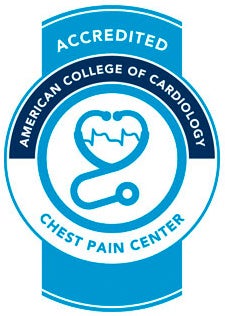Chest Pain
Resources, Prevention and Wellness
Learn MoreNeed a Cardiologist?
Request an AppointmentChest pain is one of the most common reasons people call 911 for emergency medical help and go to the emergency room.
Chest pain should never be taken lightly.
That's why the WakeMed system features three accredited Chest Pain Centers at WakeMed Raleigh Campus, Cary Hospital and North Hospital.


When to Seek Help for Chest Pain
If chest pain worsens, lasts more than five minutes—especially when accompanied by weakness, feeling faint, shortness of breath, nausea, vomiting and/or sweating—you could be having a heart attack.
Dial 911 immediately—do not drive yourself to the emergency room—if you feel any of the following:
- Pain, squeezing, fullness or discomfort in the chest that lasts for several minutes (symptoms can go away and come back)
- Pain that radiates to other parts of the body, such as the arms, neck, back or jaw
- Shortness of breath
- Sweating, nausea, vomiting or dizziness
Speedy treatment often means the difference between life and death, as well as between disability and a return to an active lifestyle after a heart attack.
Causes of Chest Pain
Chest pain has many possible causes, all of which deserve medical attention. Chest pain can result from both heart-related (cardiac) and non-heart-related (non-cardiac) issues.
Angina
Fatty deposits can build up in the arteries that carry blood to your heart, narrowing them and restricting blood flow. Angina is chest pain caused by a temporary loss of blood to the heart muscle. It can be brought on by exercise, emotion, eating—especially heavy meals—and exposure to extreme hot or cold temperatures. Angina usually goes away within minutes after stopping the stressful activity, and it does not damage the heart muscle.
Heart Attack
A heart attack may seem to happen suddenly, but it’s usually the result of a slow buildup of fat and cholesterol that narrows the coronary arteries. A blood clot can form in the narrowed artery, keeping blood from getting to the heart muscle.
Without a blood supply, the heart muscle begins to die, causing pain, pressure and/or feelings of fullness, tightness or burning in the chest. The pain may radiate to the back, shoulders, neck and arms, or the shoulders, arms or wrists may feel numb.
Other symptoms of a heart attack can include:
- Dizziness
- Shortness of breath
- Faintness
- Breaking out in cold sweats
- Sick to the stomach
- Vomiting
- Changes in the heart's rhythm
While both men and women may have any these symptoms, women also may experience more subtle flu-like symptoms, feelings of anxiety or nervousness, atypical chest pain and swelling in the ankles or legs.
Coronary Artery Spasm
A coronary artery spasm temporarily closes the blood flow to the heart. Spasm of the coronary arteries may occur spontaneously or be triggered by a stimulant such as nicotine, caffeine or chemicals.
Mitral Valve Prolapse
Mitral valve prolapse occurs when the heart’s mitral valve does not open and close smoothly.
Other Causes for Chest Pain
There are other cardiac and non-cardiac causes for chest pain. Inflammation around the heart's protective sac is called pericarditis and it can cause chest pain. Or, the heart's other valves may have issues that need to be addressed.
Non-cardiac causes of chest pain include:
- Heartburn
- Asthma
- Peptic ulcer
- Bronchitis
- Pneumonia
- Stress
- Anxiety/panic attack
- Pleurisy
- Blood clot in the lung (pulmonary embolism)
- Sore muscles
- Chest or rib injury
- Pinched nerve
Diagnosing and Evaluating Chest Pain
Cardiac imaging studies can be used to determine if chest pain is caused by conditions such as heart disease, cardiac aneurysms (weak, bulging spots in arteries) or issues with cardiac valves or other heart structures. These imaging studies may include:
- Echocardiogram ("echo") tests: Echocardiography is a type of cardiac imaging that uses sound waves to create moving pictures of the heart and its blood vessels at rest and during exercise. Echocardiogram images help cardiologists diagnose, evaluate and monitor many heart conditions.
- Cardiac CT and MRI: Cardiac computed tomography (CT) and magnetic resonance imaging (MRI) are two advanced, non-invasive ways to look inside the heart and thoroughly assess the cardiovascular structures.
Treating Chest Pain
The treatment for chest pain depends on its cause. Chest pain caused by muscle strain or injury, for example, may be treated with an analgesic medication, while chest pain caused by pneumonia or bronchitis may be treated with an antibiotic.
If chest pain is determined to be related to a cardiovascular concern, the appropriate treatment depends upon the exact nature of the issue. Medications used to treat heart conditions include beta blockers, blood thinners and statins. There are also a variety of heart procedures and surgeries used to treat the underlying causes of cardiac-related chest pain. WakeMed Heart & Vascular also offers chest pain relief for those suffering complex coronary artery disease through our CHIP/CTO program.
Make an Appointment
Do you need a cardiologist?
- Request a Heart and Vascular Appointment
- Refer a Patient (Physicians)